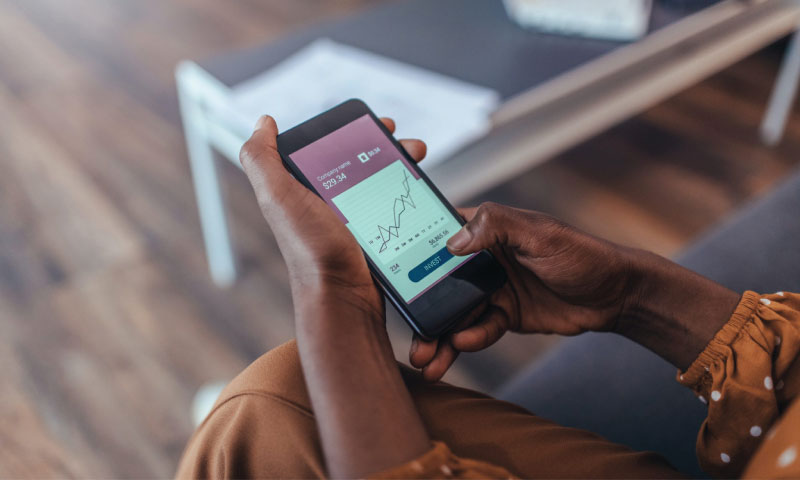An investing app is a mobile application that allows users to invest in various financial products such as stocks, bonds, mutual funds, and exchange-traded funds (ETFs). These apps are typically offered by brokerage firms, financial institutions, or fintech companies.
Investing apps work by providing users with a platform to manage their investments. Users can create an account, link their bank account, and deposit funds into their investment account. They can then use the app to research and select investment products, place trades, monitor their portfolio, and track their investment performance.
In this article, we will learn about investing app must-have features, successful examples, and how to create an investing app.

Types of Investing Apps
There are many different types of investing apps available, each with its own set of features and benefits. From brokerage apps that allow users to invest in various financial products, to robo-advisors that use algorithms to manage portfolios, to social trading apps that allow users to follow and copy the investment strategies of other users, there are many options to choose from. Let’s look at them closer:
- Brokerage apps: These apps are offered by online brokerage firms and allow users to invest in various financial products such as stocks, bonds, mutual funds, and ETFs. They typically charge fees and commissions for trades and may offer advanced trading tools and research.
- Robo-advisor apps: These apps use algorithms and computerized models to automatically invest and manage users' portfolios based on their investment goals and risk tolerance. They may offer lower fees than traditional financial advisors and may be a good option for those who want a hands-off approach to investing.
- Micro-investing apps: These apps allow users to invest small amounts of money, often in increments as low as a few cents. They may round up purchases or invest spare change to help users build a portfolio over time. They are often designed to make investing more accessible to younger or less affluent users.
- Social trading apps: These apps allow users to follow and copy the investment strategies of other users, often called "gurus" or "leaders." They may also offer a social network-like experience where users can discuss investments and share information.
- Education and research apps: These apps provide educational resources and research tools to help users make informed investment decisions. They may offer news, analysis, and data on various financial products and markets.
- Cryptocurrency trading apps: These apps allow users to buy and sell various cryptocurrencies, such as Bitcoin and Ethereum. They may offer real-time market data and trading tools for users to manage their crypto investments.
There are many different types of investing apps available, each with its own strengths and weaknesses. Before developing an investing app carefully evaluate your users' investment needs and goals.
Successful Examples of Investing Apps
There are many successful cases to date, but some are better known and more widely used. Let's look at a few examples below:
- Robinhood — buy and sell stocks, ETFs and options, and market analysis. Robinhood revolutionized the investment industry by allowing you to trade the market without commissions.
- Betterment — invest your money in a portfolio of instruments that are managed by artificial intelligence algorithms.
- Coinbase — allows you to buy, sell and store a variety of cryptocurrencies.
- Fundrise — invest in a real estate portfolio that is managed by professional investment managers. Fundrise promises high returns for investors.
- ETRADE — trading in financial markets, which was launched in 1982. It allows you to trade stocks, options, ETFs and other financial instruments.
Must-have Features of an Investing App
There are several must-have features to include in an investing app:
- Account setup: The app should make it easy to create an account, link a bank account, and deposit funds into the investment account.
- Security: The app should provide robust security measures to protect user data and investments, such as encryption, two-factor authentication, and biometric login options.
- Investment options: The app should provide a wide range of investment options, including stocks, bonds, mutual funds, ETFs, and other financial products.
- Research and analysis tools: The app should provide research and analysis tools to help users make informed investment decisions, such as real-time market data, news and analysis, and investment research reports.
- Portfolio management: The app should allow users to manage their portfolios, view their investment performance, and make trades easily and quickly.
- User-friendly interface: The app should have a user-friendly interface that is easy to navigate and understand, even for beginners.
- Customer support: The app should provide responsive customer support, such as email, phone, or chat, to help users with any issues or questions.
- Low fees: The app should offer low fees and commissions, compared to traditional brokerage firms, to make investing more affordable for users.
An investing app should provide a comprehensive and user-friendly platform for managing investments, with robust security measures, research and analysis tools, and a wide range of investment options.
The Process of Developing an Investing App
The development process begins with market research and competitor analysis: We need to analyze the market in which we plan to operate, study the needs and concerns of potential users and study the competitors. Then we have the following algorithm of actions:
- Definition of functions and requirements: At this stage, the main functions and requirements for its operation are defined.
- Designing the interface and UX: This is important because everything must be user-friendly and easy to use.
- Functionality and architecture are designed, and testing is done to detect and fix bugs.
- After testing and debugging, everything is ready to go live. Monetization is decided at this stage.
- Once launched, the platform must be constantly updated and improved to meet the changing needs of users and changes in the investment market. Technical support and troubleshooting are also needed.
In addition, development may include data collection and analysis, use of artificial intelligence and machine learning for market forecasting, and compliance with regulatory and legal requirements for financial technology and investments.
Ways to Monetize Your Investing App
There are several ways to monetize your app. You can charge a commission for trading on an exchange or investing in certain stocks or funds. There are also other ways:
- Paid subscriptions to additional features, such as analyst reports or access to exclusive information.
- Advertising financial products related to investing and getting money from advertisers.
- White label, which allows you to sell functionality.
- The app can be linked to financial institutions that can offer their products, such as investment funds or banking products.
- You can collect and sell anonymized data, such as for market research or new project development.
Each method of monetization has its advantages and disadvantages, and the choice depends on the developer's goals and user needs.

Conclusion
In 2023, the development of such projects becomes an even more relevant and promising field. With the growing number of people interested in investing and the increasing availability of technology, creating user-friendly and functional projects can be a successful business.
However, to stand out in the market and attract a larger audience, you need to develop a project with innovative features such as analytics, personalized recommendations and a user-friendly interface. It is also worth paying attention to the protection of users' personal data and ensuring the security of transactions.
Monetization can be done through trading commissions, paid subscriptions, advertising, partnerships with financial institutions, or selling data. Investing app continues to be an important topic for developers and investors, and a well-designed product can lead to success and high returns.